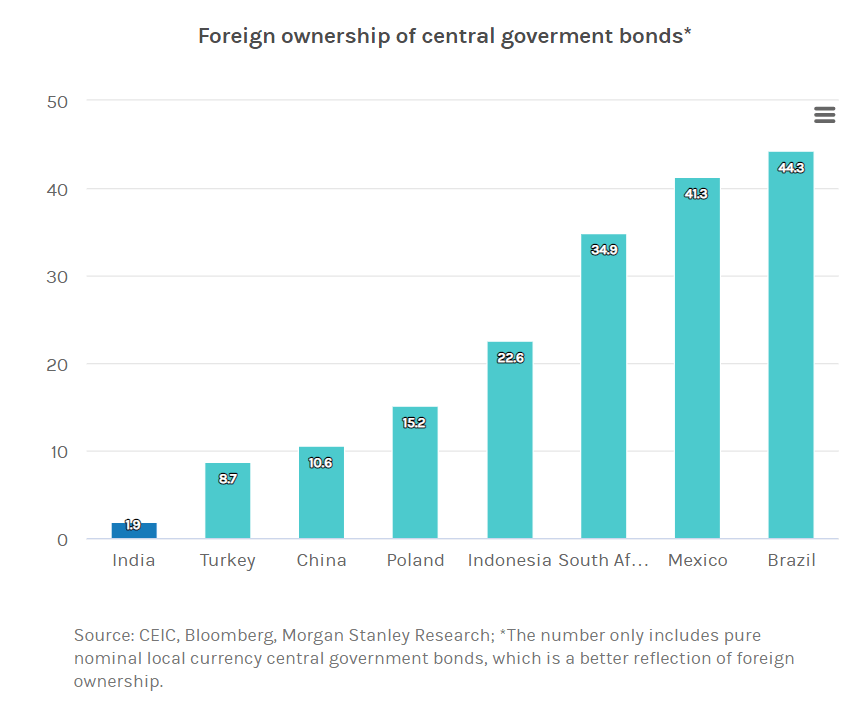India is hopeful and on the cusp of making history as it is eyeing the maiden listing of a local bond in a major global bond index by 2023. If you believe market experts, then it’s just a matter of time not whether India will join the large global bonds index or not.
The inclusion of the global bonds index will be a big development for the world’s fifth-largest economy. But why does it matter for India, and what are the benefits of being included in global bond indices?
Let’s try to get a better idea of the economics of the Global Bond Index.
What is the Global Bond Index?
Like the global equity index that tracks the equity market of developed and emerging economies, the global bonds index tracks the debt market of emerging economies by including local currency bonds governments of various countries issue.
A few of the leading global bond indices include JP Morgan GBI- EM Global Diversified Index, Bloomberg Global Aggregate Index, Morgan Stanley, Merrill Lynch Global Bond Index, etc. For instance, JP Morgan GBI- EM Global Diversified Index tracks the debt market of 16 emerging economies from Asia, Europe, Latin America, and the Middle East and Africa. It has a 10% cap and 1% floor, meaning, a country’s share in the index is capped at 10%, with 1% being the minimum share.
Why is India not included in the global bonds index?
The bonds market globally, including in India is highly regulated, with multiple checks and processes put in place to safeguard the country’s economic interest. So far, India’s exclusion from the global bonds index was primarily due to capital control problems, issues related to settlement, and taxation.
One of the key contentious issues for foreign institutional investors to invest in local currency bonds is settlement and taxation. For instance, there is no exemption from taxes on international bond transactions, and the settlement must be done locally.
Why does India’s Inclusion in Global Bonds Index Matter?
As per RBI estimates in its June 2022 report, the size of the government-issued bond market in India is Rs 84.71 lakh crore. Mostly domestic institutions viz the banks, mutual fund houses, and retirement fund bodies subscribe to the bonds the government issues. And Foreign Portfolio Investors (FPI) hold less than 2% of all outstanding government debt.

The inclusion of Indian government bonds in the global bonds index would result in an additional inflow of $30 to $40 billion of foreign funds into the Indian economy.
In a Morgan Stanley report, the inclusion of Indian government bonds in global bonds indices would entirely change the dynamics of the global bonds market, as portfolios pegged to benchmark indices would need to be readjusted, resulting in index-related inflows and outflows.
For instance, India’s portfolio weightage in the JPM GBI- EM Global Diversified Index could be 9.2%, the second largest after China, and inclusion into one more global bonds index could bring in $18.5 billion in annual inflows over the next decade. From little under 2%, the share of foreign portfolio investors in the Indian debt market would rise to 9% by 2031.
Economic Benefits for India
From a competitive currency to greater financial flexibility, India’s inclusion in the global bonds market can yield economic benefits. A few major benefits are:
Stronger Rupee: The inclusion of India’s local currency bonds in global bonds indices will indicate the government’s seriousness in spurring growth through investment. More foreign investment will help in improving the country’s balance of payments (BOP) situation. The inflow of investments would lead to the flow of capital helping India build capacities, replace costly imports with domestically manufactured goods and promote exports. Also, it will indirectly create an environment for low-cost capital.
A surplus balance of payments situation and a lower fiscal deficit position will help to strengthen the rupee against major currencies. In the last three years, China’s share in the global bonds index has reached 11%, up from 7.6%. The inclusion has helped in the growth of the fixed-income market and the globalization of the yuan.
Reduced pressure on domestic financial institutions: At present, most domestic banks and other financial institutions subscribe to government bonds. Once, foreign flows start coming into the Indian debt market, it will result in a significant reduction of pressure on banks and ensure greater availability of funds, reducing the cost of funds.
Expected surge in passive investments: Like the equity market, most portfolio inflows in the bond market come through index funds and ETFs that track the global bond indices. Once Indian government bonds are added to the global bond indices, it will bring larger portfolio funds into the country from such passive funds.
Improve goodwill of Indian debt market: As an emerging economy, India’s credit rating downgrade or the rupee volatility results in huge capital outflow which impacts the stability and steadiness of the debt market. Strong foreign inflows will add credit and goodwill to India’s growth story, reduce the impact of such risks, and make the debt market more liquid.
Conclusion
The benefits of India in the global bond index are many. making India more competitive on the world map. But there are a few hurdles to clear, like the capital gain tax on foreigners who invest in Indian bonds, 6% cap on investment limit, and taxing regulatory requirements.
Overall, for an emerging market like India, opening the debt market to foreign investors will help to protect investors’ returns, bring stability, and improve liquidity in this uncertain and rising interest rate environment.
FAQs
What is the global bonds index?
The global bonds index tracks the performance of local currency bonds emerging economies issue or the debt market of various countries.
Which are the leading global bond indices?
JP Morgan GBI- EM Global Diversified Index, Bloomberg Global Aggregate Index, Morgan Stanley, and Merill Lynch Global Bond Index are the leading global bond indices.
What are the economic benefits a country gets from inclusion in the global bonds index?
A few key benefits include the greater flow of foreign funds into the economy, stronger local currency, low capital cost, and improved goodwill of the country’s debt market.
How useful was this post?
Click on a star to rate it!
Average rating 3 / 5. Vote count: 2
No votes so far! Be the first to rate this post.
























